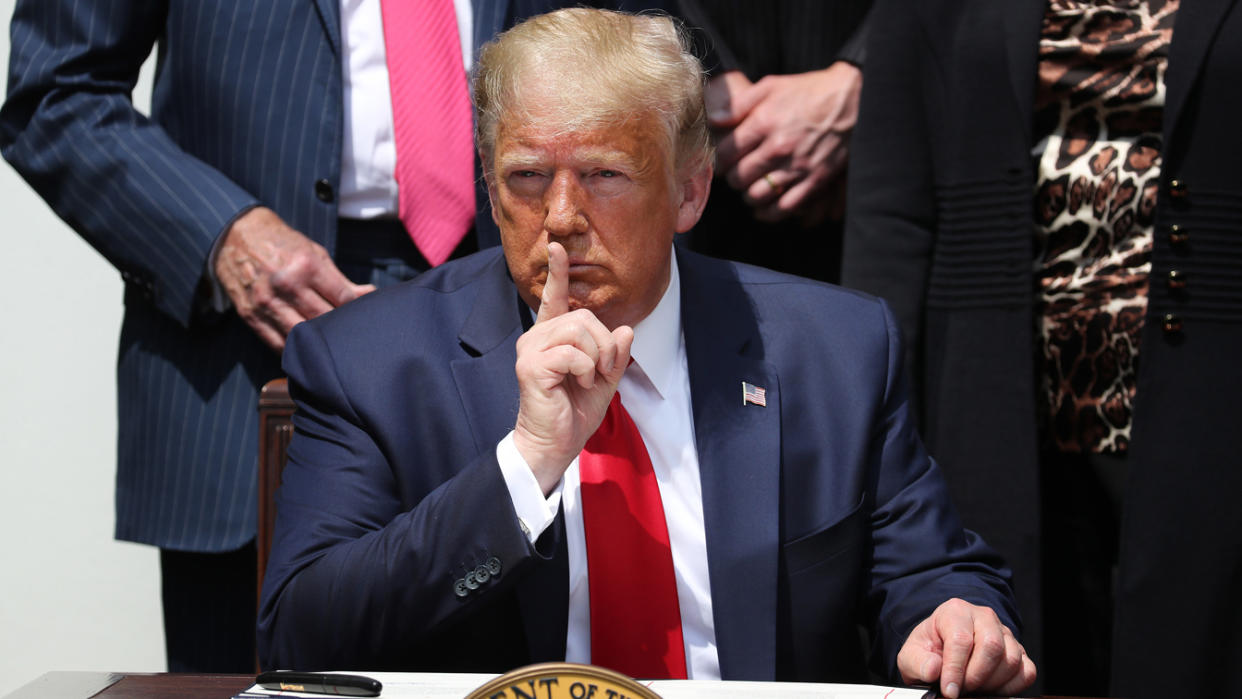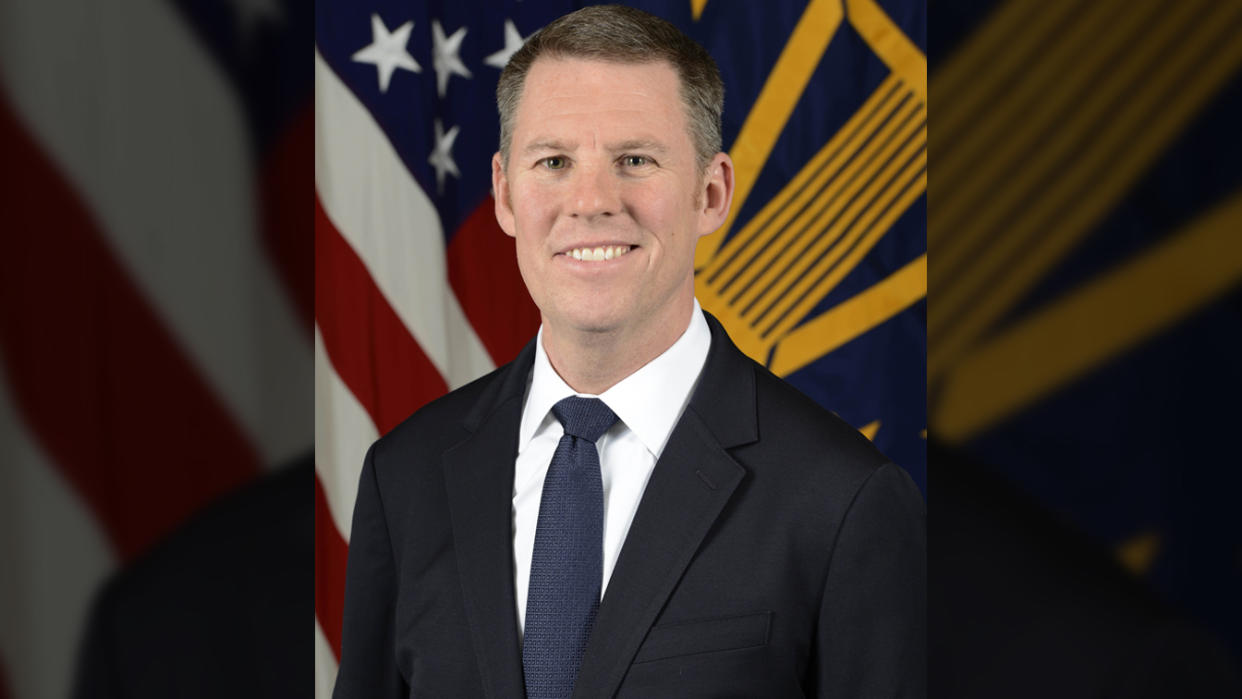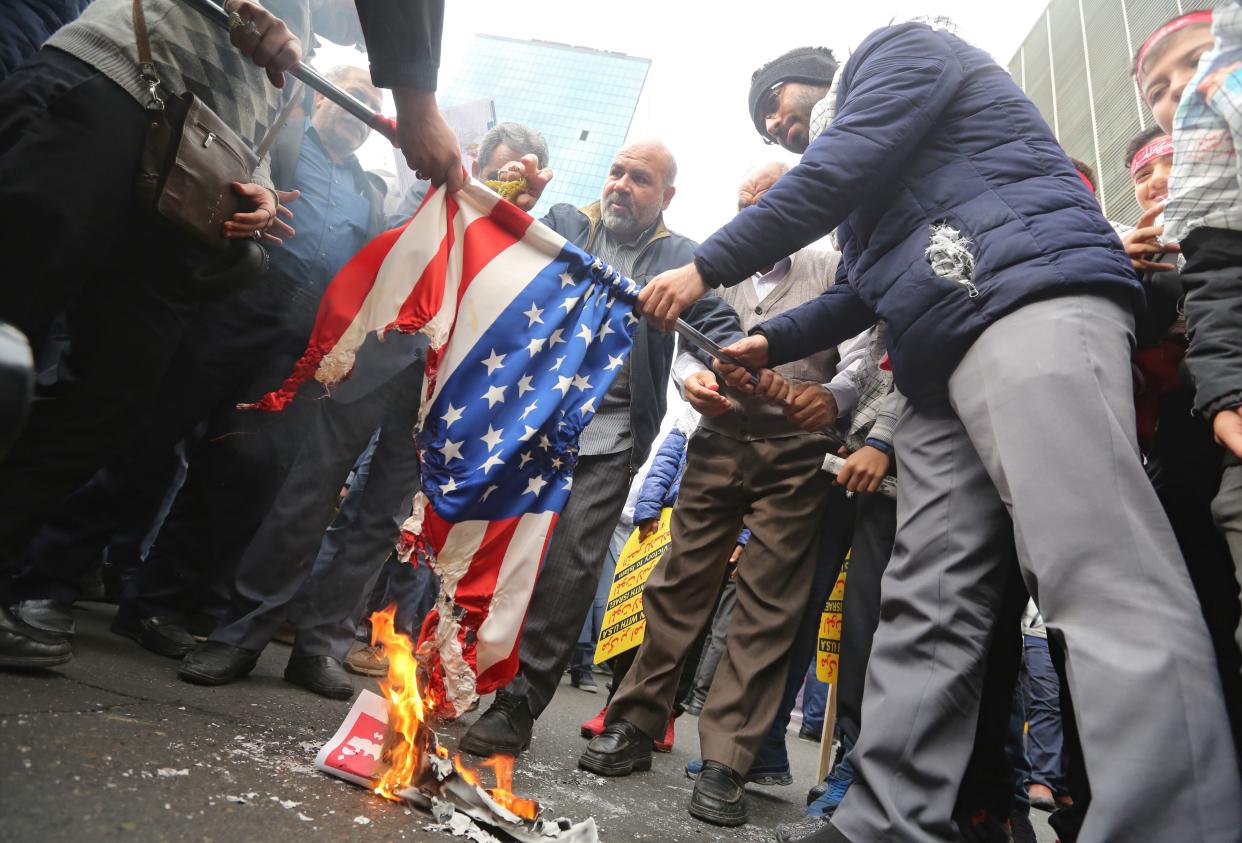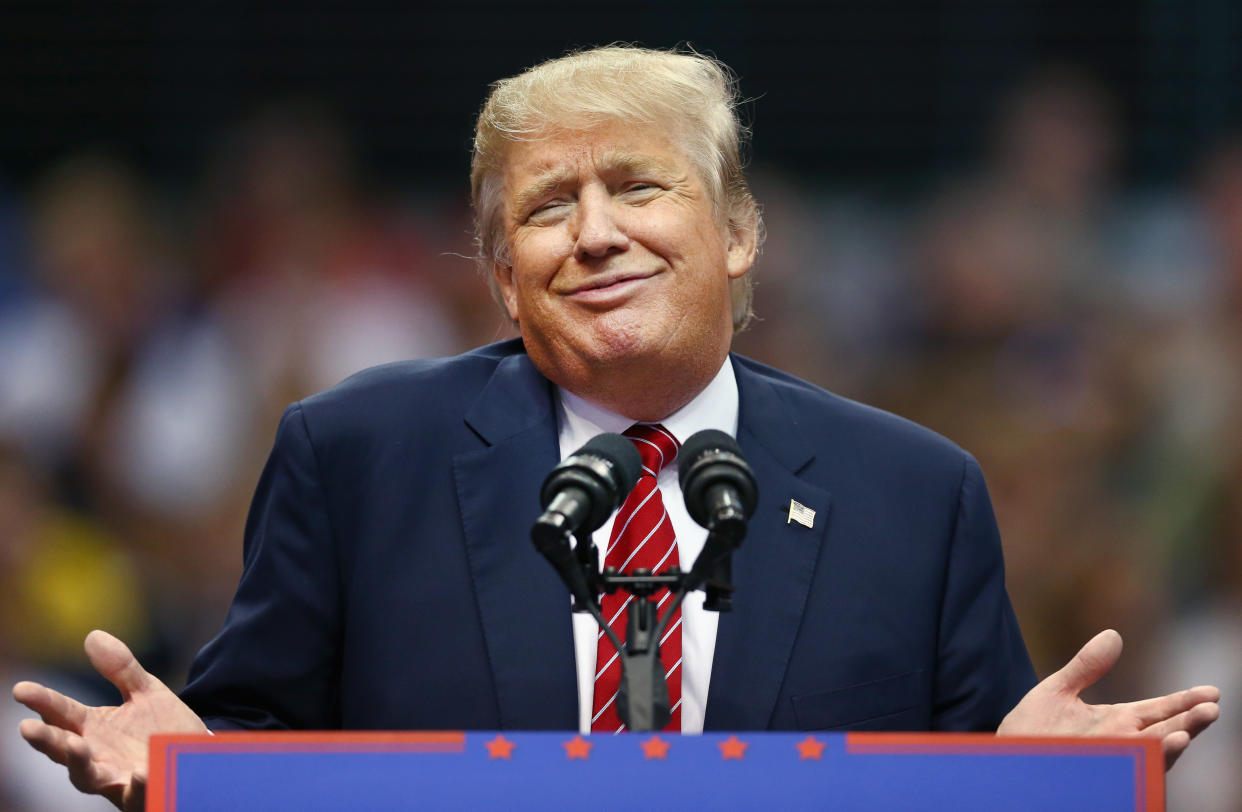More than two years after Trump tweeted a classified image of Iran, former officials are divided on fallout
On the morning of Aug. 30, 2019, then-President Donald Trump was receiving his daily intelligence briefing with a a select group of senior national security officials, including CIA Director Gina Haspel, national security adviser John Bolton and other top aides.
U.S. officials at the meeting were delighted. The previous day, Iran had attempted to launch a satellite into space, but the launch had failed spectacularly, with the rocket exploding on the pad.
Included in that morning’s briefing materials was a classified image, taken by satellite, of the botched rocket launch, showing extensive damage to the site.
The president was taken by the image. “Trump thought this was very neat, and asked if he could keep it,” said a former Trump administration official. “And after some hesitation, the intelligence briefer said, 'Yes.'"
Officials had been nervous about leaving the image with the president, according to the former official, who attended the meeting. “Gina [and other intelligence officials] may have said something like, ‘Well, don’t do anything with it, don’t show it to anybody.’ But I think he just blew them off. He said, ‘I just want to look at the picture.’”
About an hour later, Trump tweeted the picture.

Some officials worried that Trump’s decision to release the image compromised a key U.S. spy capability, potentially giving Iran a leg up in concealing its nuclear and missile programs. Now, with the U.S. and Iran embroiled in contentious indirect negotiations over salvaging the 2015 nuclear deal, from which the Trump administration withdrew in 2018 and Iran appearing to prepare for another satellite launch, officials and experts are still split on the fallout from Trump’s move.
“Any effort the U.S. or our allies are taking to disrupt or monitor” Iranian satellite launches “should have been held in the utmost secrecy,” said Michael Mulroy, who served as deputy assistant secretary of defense for the Middle East from 2017 to late 2019.
The same technology used to propel satellites into orbit can be used to develop ballistic missiles, so top U.S. officials kept a close eye on these launches, worried that Tehran was aiming to develop weapons — including, in the future, nuclear ones — that could strike anywhere on Earth.
“Iran is closer to a nuclear weapon than it was while in the [2015] agreement,” says Mulroy. “By some estimates, they could have one in a matter of months. This makes their efforts to develop a delivery system even more important.”

But during the Trump presidency, officials had difficulty getting the president’s attention on the subject. “It was simply not something, despite repeated efforts, I could get Trump to focus on strategically,” wrote Bolton in “The Room Where It Happened,” an account of his time in the Trump administration.
One thing is certain: President Trump’s decision to release the classified image was anything but conventional. Trump could not attach the photo to a tweet digitally, since the electronic devices some use to access their classified daily intelligence briefs are cut off from the open Internet. So Trump had an aide take a photo of the picture from the hard copy of Trump’s daily brief and post it online, according to the former Trump administration official.
Trump's move seemed designed to mock the Iranians and raise the specter of U.S. sabotage. “The United States of America was not involved in the catastrophic accident during final launch preparations for the Safir SLV Launch at Semnan Launch Site One in Iran. I wish Iran best wishes and good luck in determining what happened at Site One,” he tweeted in the text that accompanied the image.
U.S. presidents have unlimited authority to declassify information, but the decision to release this image from a U.S. spy satellite — without interagency discussion or first degrading the image quality, and on such an expedited timeline — was likely unprecedented, according to former officials. (Indeed, academic analysts, using commercially available imagery, had already exposed the failed launch before the president’s tweet.)

Although U.S. spy satellites’ orbital paths are widely known — to adversarial intelligence services, academic researchers and amateur astronomers alike — images from these satellites are generally highly classified, as they reveal the satellites’ precise resolution capabilities, which are superior to commercially available technology, according to former officials.
The intelligence community was “extraordinarily unhappy” that Trump released the image, said the former Trump administration official, adding that a senior intelligence official called him after the tweet asking “what the f*** was going on” at the White House.
The tweet of the image was “incredibly stupid and ridiculous and damaging,” said a former senior official at the National Reconnaissance Office (NRO), the agency responsible for U.S. spy satellites.
The Office of the Director of National Intelligence and National Reconnaissance Office did not return requests for comment.
Some Trump-era officials recall the president’s decision differently.
Trump brought up publishing the image at the morning intelligence meeting, said a former senior White House official who also attended the meeting. And while CIA Director Haspel and other intelligence officials were opposed to the idea, “they didn’t blow a gasket over it,” said the former official. In fact, this person recalled, the image was only classified at the “secret” level.

There was little pushback from top intelligence community and Pentagon officials about releasing the photo, according to multiple Trump administration officials. “There was no particular angst” about releasing the photo, said a former senior intelligence official.
“It wasn’t a crown jewel, by any stretch of it,” says the former senior White House official. And in any case, say Trump era officials, advances in commercially available satellite imagery meant that the picture that the president released wasn’t much better than what was widely publicly available.
Not so, says the former senior NRO official. The image Trump released was classified at the “top secret codeword” level — that is, the highest possible level of secrecy, said this former official. The image was taken by a KH-11 series reconnaissance satellite — among the most sensitive employed by the U.S. intelligence community, according to former officials.
The tweet cost “billions” in damage, estimated the former senior NRO official. “The gift that [the Iranians] were given was, ‘Oh, the Americans have this capability with this satellite series, now we know,’” said the former senior NRO official. “It’s because they saw the resolution” the satellite was capable of, added this official.
At the NRO, officials worried about what their platforms might now be missing, since Iran and other U.S. adversaries — newly aware of U.S. spy satellite powers — would likely change their behaviors. “It degraded our confidence in that capability to pick up things that we might otherwise have picked up,” said this former official.

The image revealed U.S. spy satellite resolution capabilities that are three times better than the best commercially available imagery, says Jeffrey Lewis, a professor at the Middlebury Institute of International Studies and expert on satellite imagery. “Mathematically, it’s not an order of magnitude better, but analytically, it was an order of magnitude better.”
Lewis found the image highly instructive. “As an outsider who tries to keep very close tabs on what the U.S. intelligence community is doing on the classified side,” the image “was a goldmine, and I learned a lot,” he says.
Lewis believes that the release of the image likely “had an impact on intelligence communities around the world.”
“I don’t want to exaggerate how bad it was,” says Lewis, who notes he is generally an advocate for greater government openness. “It’s not that the satellites stopped working. It’s just that it aids countries in deceiving those satellites.”
Lewis says Iran has introduced new measures to make satellite-based analysis of their launch activities more difficult, which he attributes to a mix of what the Iranians learned from the image released by Trump, as well as the increased public scrutiny from open source analysts like him. What precisely caused the change in Iranian behavior is “hard to disentangle,” Lewis says.
Some Trump administration officials dismissed the concerns about revealing the image as overblown.
“I also heard those whines and whimpers and clutching of pearls” from the intelligence community about the tweeted image, said a former senior administration official. “But I did not see any change [in spy satellite capabilities], or nobody gave me a convincing case of why that mattered.”
The former senior intelligence official chalked it up to “parochial concerns” at the NRO. “To be very blunt, NRO thinks any satellite imagery that is ever released anywhere is a big deal, whether it comes from them or anyone else,” said this former official.

But NRO officials were shocked — and too intimidated to speak up, recalled the former senior NRO official.
“It was almost like, you don’t want to bring the weight of the president” onto NRO “because you can see that he’s just gone with a flamethrower with the FBI and CIA,” said this former official. “And NRO was like, we just want to be left alone.”
The president’s actions were calculated, according to the former senior White House official. Trump said that the tweet will “get inside the Iranians’ head, whether [the explosion on the launchpad] was an accident or not,” said this former official. “He was pretty convinced he was going” to tweet the image, “and he did it.”
The former official denied that the explosion was the result of U.S. covert action. “The missile blew up; it wasn’t anything we did to it,” he said.
The Iranians “are extremely accident-prone right now” because they lack the funds to do the necessary upkeep on their space program, said the former senior administration official. “There are things that do just happen by accident.”
But others were less definitive about the explosion being accidental. “There was a lot of heartburn” over the tweet, says a former senior Pentagon official. “If you’ve had, generally speaking, covert action success, you need to keep it covert. Because that’s what made it a success.”


